Summer 2019 ITEC2600 MATLAB Data Analysis Project Report
VerifiedAdded on 2022/10/16
|13
|1558
|283
Project
AI Summary
This project uses MATLAB to analyze the Credit Approval Data Set from the UCI Machine Learning Repository. The project begins by importing the data into MATLAB and converting it into a suitable format for analysis. The analysis includes cleaning the data to handle missing values and inconsistent data. Various graphs, including bar graphs, box plots, and curve fitting, are generated to visualize the data and identify patterns. Statistical measures are calculated to find trends and distributions within the dataset. The analysis explores the relationship between different attributes and the credit approval outcome, leading to conclusions about the factors influencing credit grant decisions. The report details the steps followed, the commands used in MATLAB, the observations made from the graphs, and the final conclusions drawn from the analysis. The project aims to provide practical experience in data analysis using MATLAB, with a focus on real-world applications in the credit approval domain.
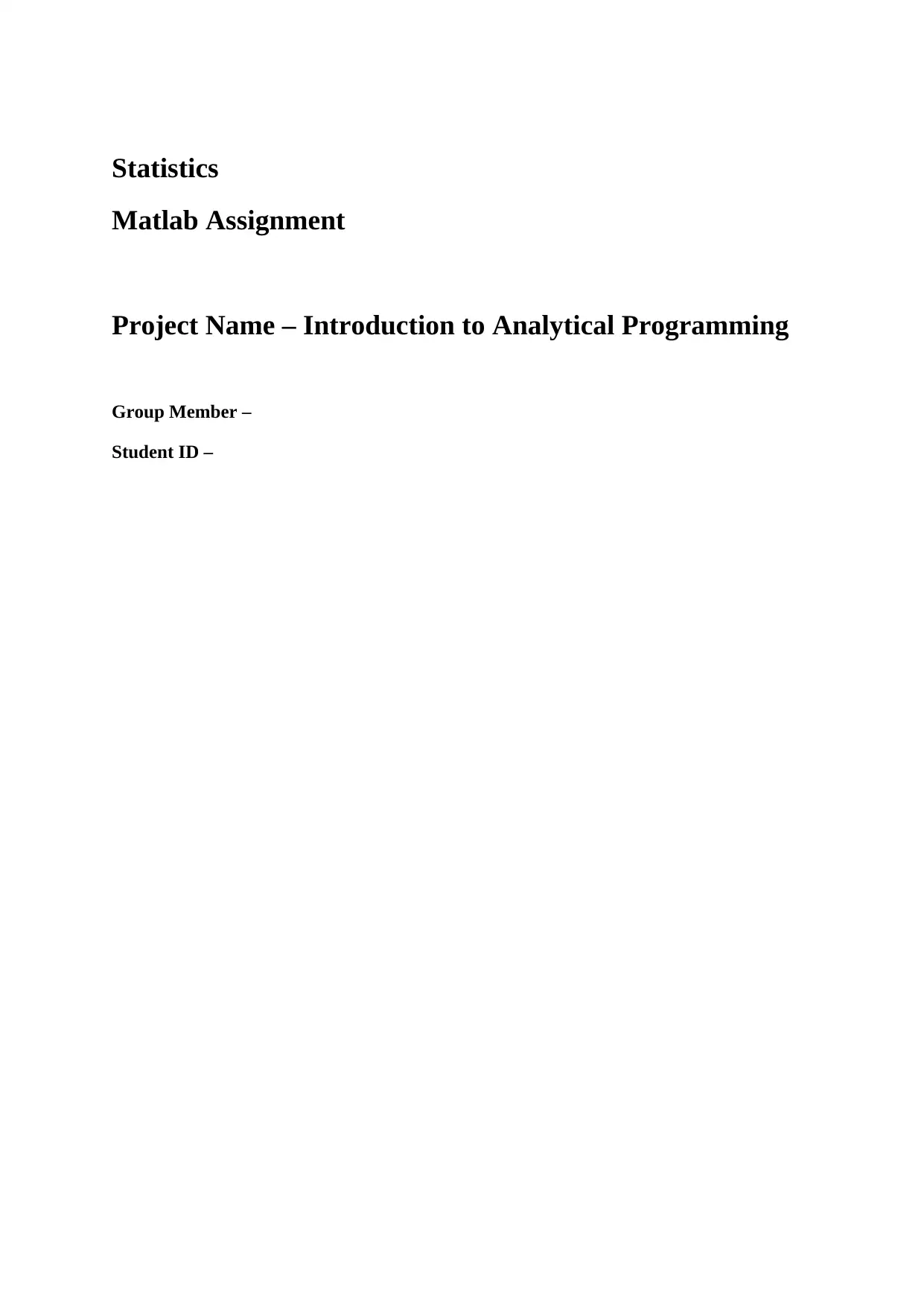
Statistics
Matlab Assignment
Project Name – Introduction to Analytical Programming
Group Member –
Student ID –
Matlab Assignment
Project Name – Introduction to Analytical Programming
Group Member –
Student ID –
Paraphrase This Document
Need a fresh take? Get an instant paraphrase of this document with our AI Paraphraser
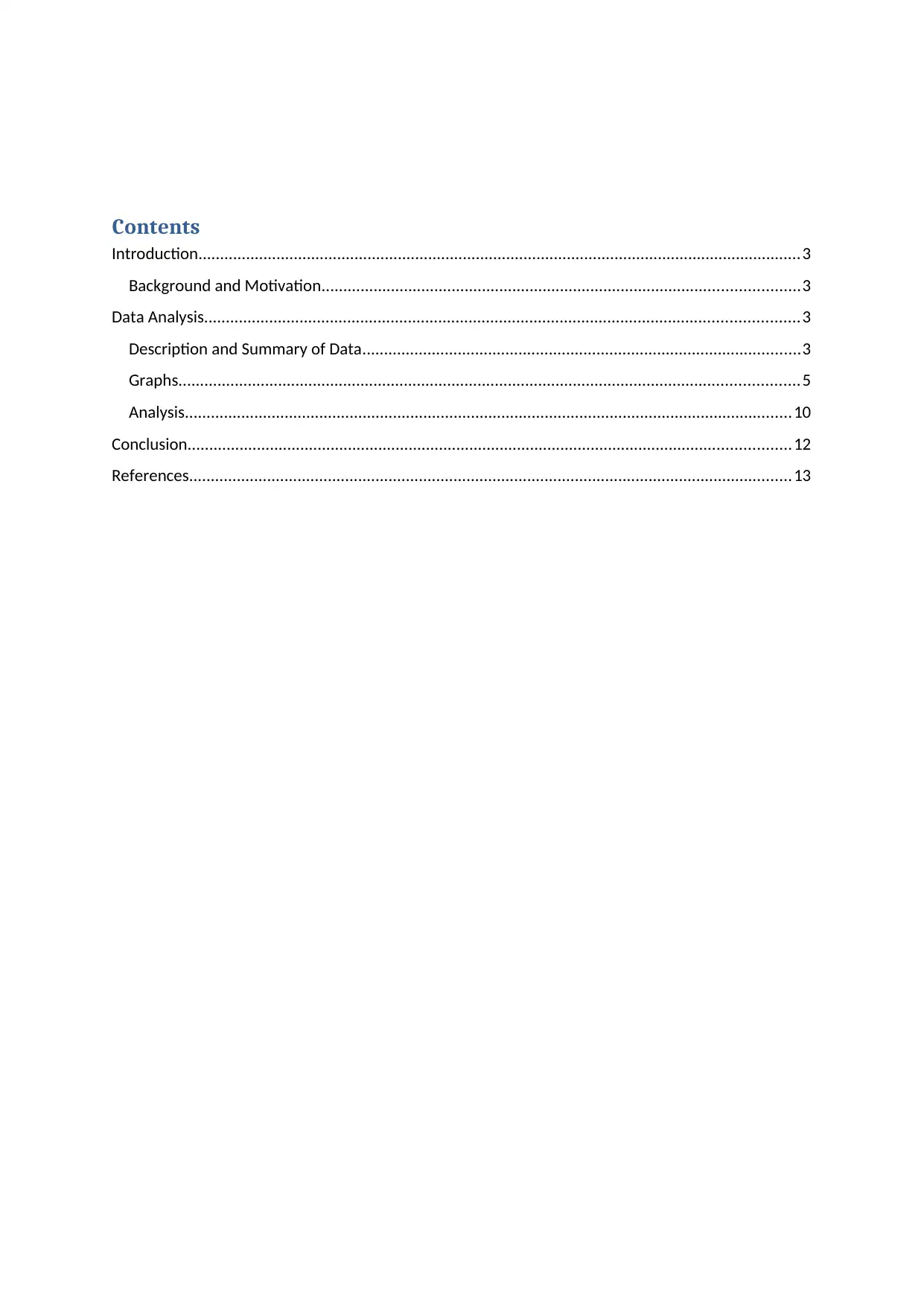
Contents
Introduction...........................................................................................................................................3
Background and Motivation..............................................................................................................3
Data Analysis.........................................................................................................................................3
Description and Summary of Data.....................................................................................................3
Graphs...............................................................................................................................................5
Analysis............................................................................................................................................10
Conclusion...........................................................................................................................................12
References...........................................................................................................................................13
Introduction...........................................................................................................................................3
Background and Motivation..............................................................................................................3
Data Analysis.........................................................................................................................................3
Description and Summary of Data.....................................................................................................3
Graphs...............................................................................................................................................5
Analysis............................................................................................................................................10
Conclusion...........................................................................................................................................12
References...........................................................................................................................................13
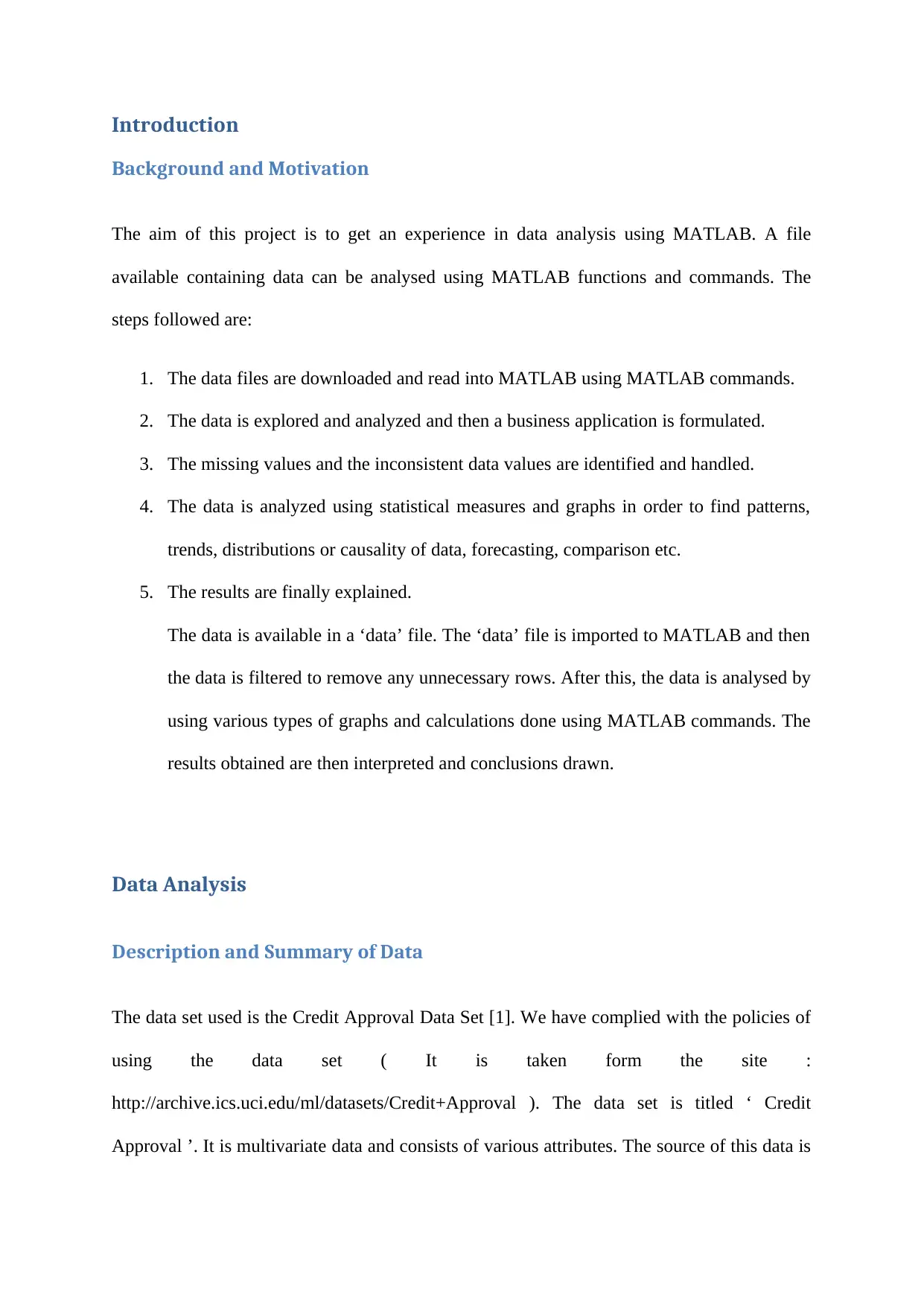
Introduction
Background and Motivation
The aim of this project is to get an experience in data analysis using MATLAB. A file
available containing data can be analysed using MATLAB functions and commands. The
steps followed are:
1. The data files are downloaded and read into MATLAB using MATLAB commands.
2. The data is explored and analyzed and then a business application is formulated.
3. The missing values and the inconsistent data values are identified and handled.
4. The data is analyzed using statistical measures and graphs in order to find patterns,
trends, distributions or causality of data, forecasting, comparison etc.
5. The results are finally explained.
The data is available in a ‘data’ file. The ‘data’ file is imported to MATLAB and then
the data is filtered to remove any unnecessary rows. After this, the data is analysed by
using various types of graphs and calculations done using MATLAB commands. The
results obtained are then interpreted and conclusions drawn.
Data Analysis
Description and Summary of Data
The data set used is the Credit Approval Data Set [1]. We have complied with the policies of
using the data set ( It is taken form the site :
http://archive.ics.uci.edu/ml/datasets/Credit+Approval ). The data set is titled ‘ Credit
Approval ’. It is multivariate data and consists of various attributes. The source of this data is
Background and Motivation
The aim of this project is to get an experience in data analysis using MATLAB. A file
available containing data can be analysed using MATLAB functions and commands. The
steps followed are:
1. The data files are downloaded and read into MATLAB using MATLAB commands.
2. The data is explored and analyzed and then a business application is formulated.
3. The missing values and the inconsistent data values are identified and handled.
4. The data is analyzed using statistical measures and graphs in order to find patterns,
trends, distributions or causality of data, forecasting, comparison etc.
5. The results are finally explained.
The data is available in a ‘data’ file. The ‘data’ file is imported to MATLAB and then
the data is filtered to remove any unnecessary rows. After this, the data is analysed by
using various types of graphs and calculations done using MATLAB commands. The
results obtained are then interpreted and conclusions drawn.
Data Analysis
Description and Summary of Data
The data set used is the Credit Approval Data Set [1]. We have complied with the policies of
using the data set ( It is taken form the site :
http://archive.ics.uci.edu/ml/datasets/Credit+Approval ). The data set is titled ‘ Credit
Approval ’. It is multivariate data and consists of various attributes. The source of this data is
⊘ This is a preview!⊘
Do you want full access?
Subscribe today to unlock all pages.

Trusted by 1+ million students worldwide
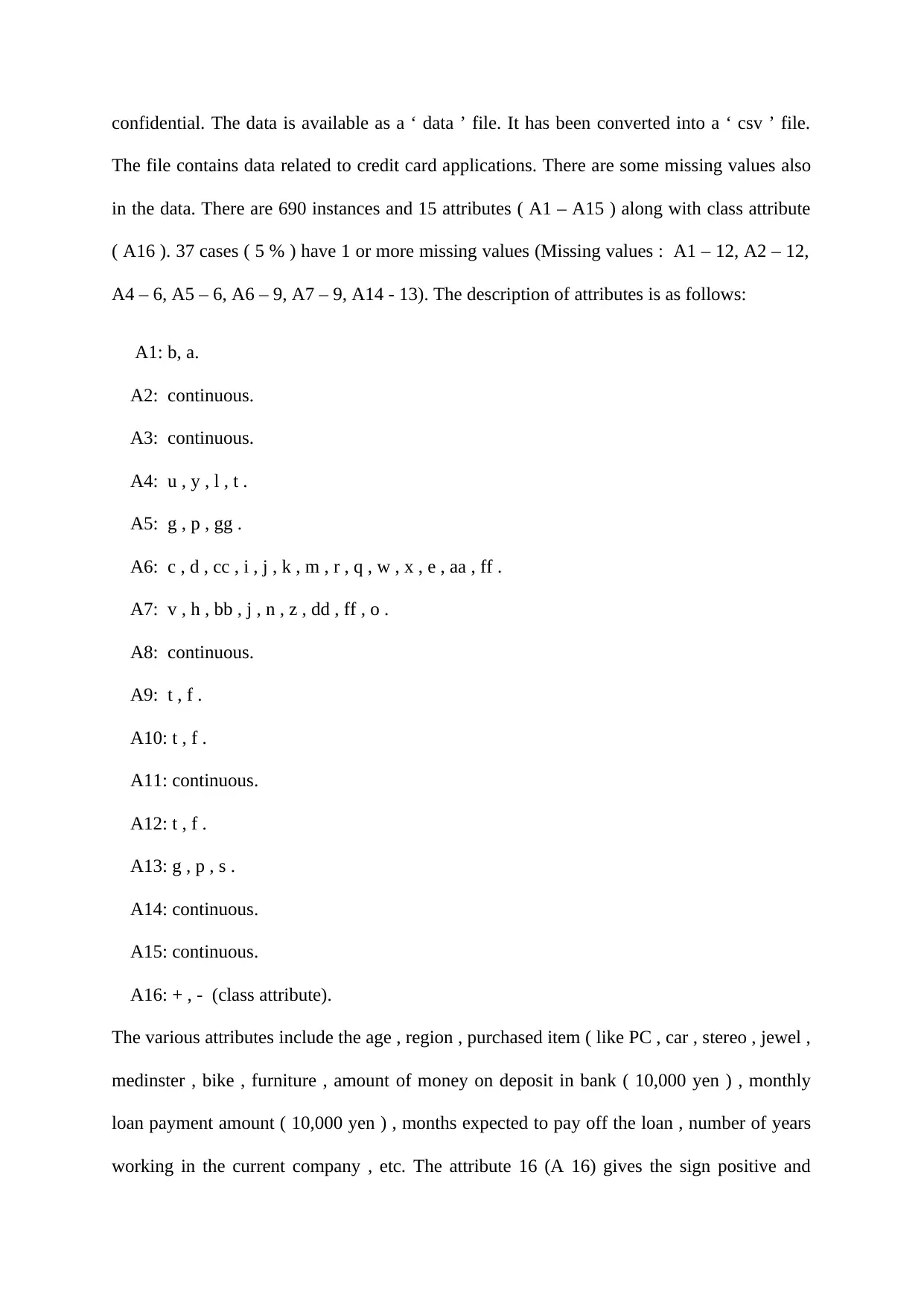
confidential. The data is available as a ‘ data ’ file. It has been converted into a ‘ csv ’ file.
The file contains data related to credit card applications. There are some missing values also
in the data. There are 690 instances and 15 attributes ( A1 – A15 ) along with class attribute
( A16 ). 37 cases ( 5 % ) have 1 or more missing values (Missing values : A1 – 12, A2 – 12,
A4 – 6, A5 – 6, A6 – 9, A7 – 9, A14 - 13). The description of attributes is as follows:
A1: b, a.
A2: continuous.
A3: continuous.
A4: u , y , l , t .
A5: g , p , gg .
A6: c , d , cc , i , j , k , m , r , q , w , x , e , aa , ff .
A7: v , h , bb , j , n , z , dd , ff , o .
A8: continuous.
A9: t , f .
A10: t , f .
A11: continuous.
A12: t , f .
A13: g , p , s .
A14: continuous.
A15: continuous.
A16: + , - (class attribute).
The various attributes include the age , region , purchased item ( like PC , car , stereo , jewel ,
medinster , bike , furniture , amount of money on deposit in bank ( 10,000 yen ) , monthly
loan payment amount ( 10,000 yen ) , months expected to pay off the loan , number of years
working in the current company , etc. The attribute 16 (A 16) gives the sign positive and
The file contains data related to credit card applications. There are some missing values also
in the data. There are 690 instances and 15 attributes ( A1 – A15 ) along with class attribute
( A16 ). 37 cases ( 5 % ) have 1 or more missing values (Missing values : A1 – 12, A2 – 12,
A4 – 6, A5 – 6, A6 – 9, A7 – 9, A14 - 13). The description of attributes is as follows:
A1: b, a.
A2: continuous.
A3: continuous.
A4: u , y , l , t .
A5: g , p , gg .
A6: c , d , cc , i , j , k , m , r , q , w , x , e , aa , ff .
A7: v , h , bb , j , n , z , dd , ff , o .
A8: continuous.
A9: t , f .
A10: t , f .
A11: continuous.
A12: t , f .
A13: g , p , s .
A14: continuous.
A15: continuous.
A16: + , - (class attribute).
The various attributes include the age , region , purchased item ( like PC , car , stereo , jewel ,
medinster , bike , furniture , amount of money on deposit in bank ( 10,000 yen ) , monthly
loan payment amount ( 10,000 yen ) , months expected to pay off the loan , number of years
working in the current company , etc. The attribute 16 (A 16) gives the sign positive and
Paraphrase This Document
Need a fresh take? Get an instant paraphrase of this document with our AI Paraphraser
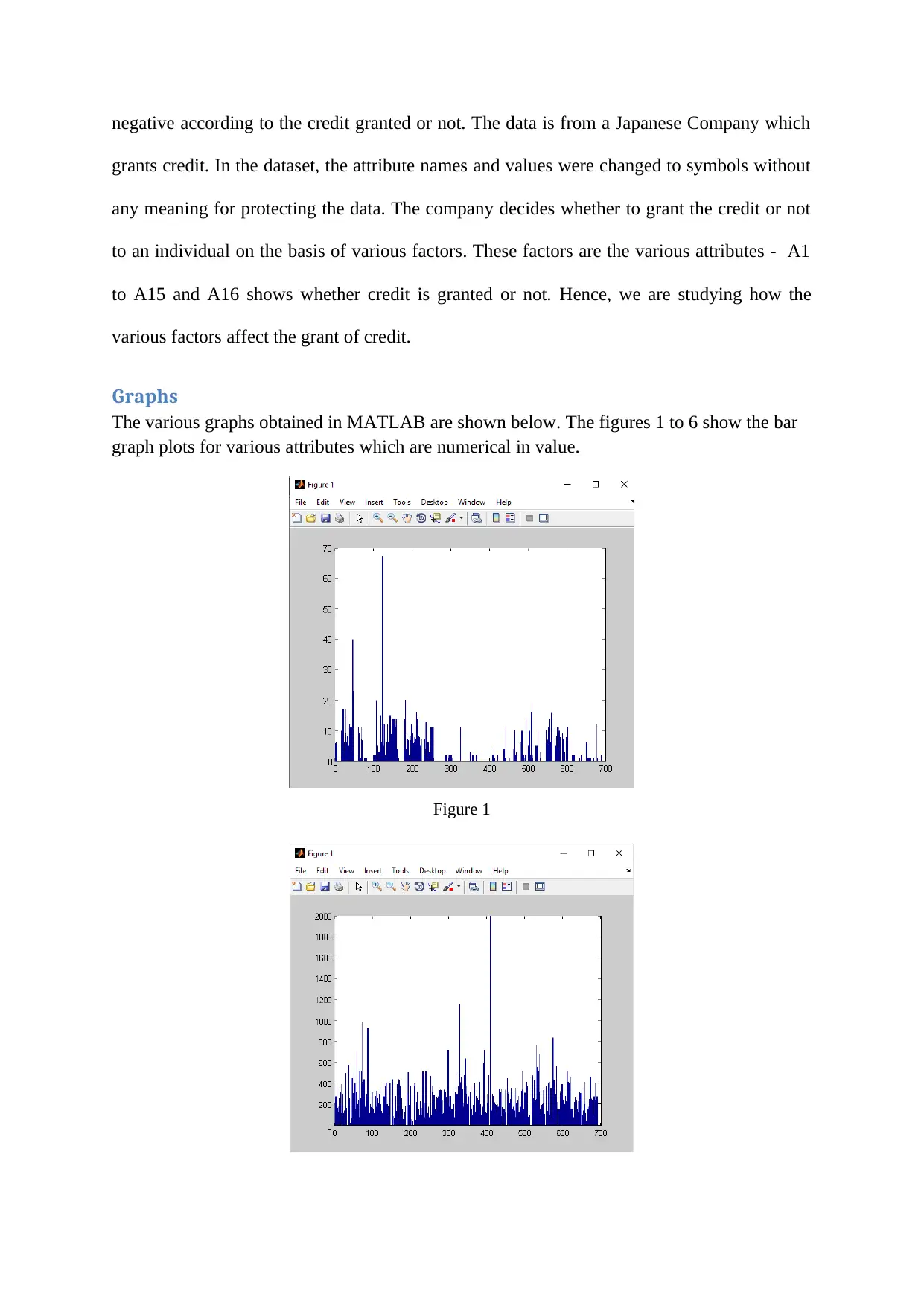
negative according to the credit granted or not. The data is from a Japanese Company which
grants credit. In the dataset, the attribute names and values were changed to symbols without
any meaning for protecting the data. The company decides whether to grant the credit or not
to an individual on the basis of various factors. These factors are the various attributes - A1
to A15 and A16 shows whether credit is granted or not. Hence, we are studying how the
various factors affect the grant of credit.
Graphs
The various graphs obtained in MATLAB are shown below. The figures 1 to 6 show the bar
graph plots for various attributes which are numerical in value.
Figure 1
grants credit. In the dataset, the attribute names and values were changed to symbols without
any meaning for protecting the data. The company decides whether to grant the credit or not
to an individual on the basis of various factors. These factors are the various attributes - A1
to A15 and A16 shows whether credit is granted or not. Hence, we are studying how the
various factors affect the grant of credit.
Graphs
The various graphs obtained in MATLAB are shown below. The figures 1 to 6 show the bar
graph plots for various attributes which are numerical in value.
Figure 1
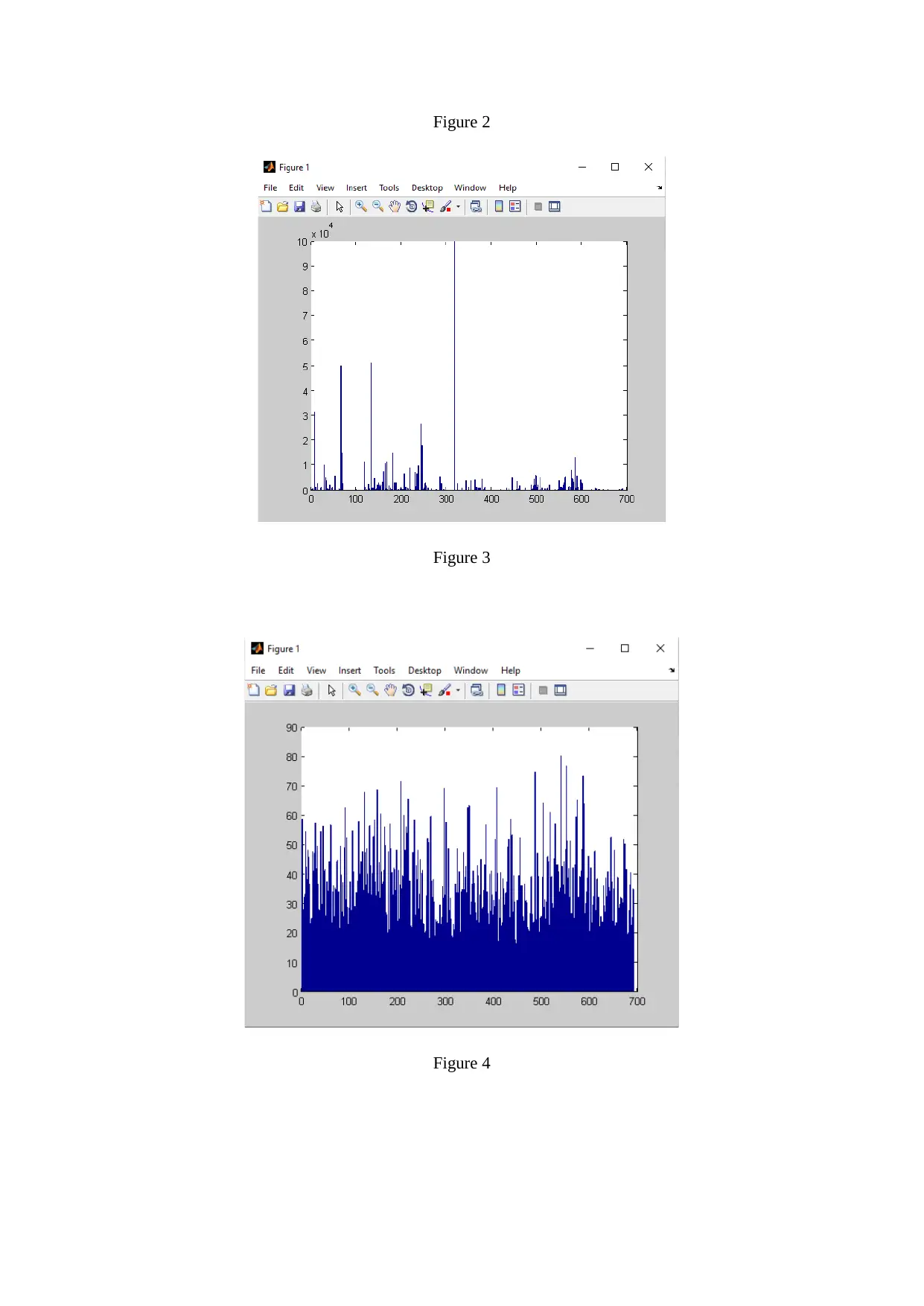
Figure 2
Figure 3
Figure 4
Figure 3
Figure 4
⊘ This is a preview!⊘
Do you want full access?
Subscribe today to unlock all pages.

Trusted by 1+ million students worldwide
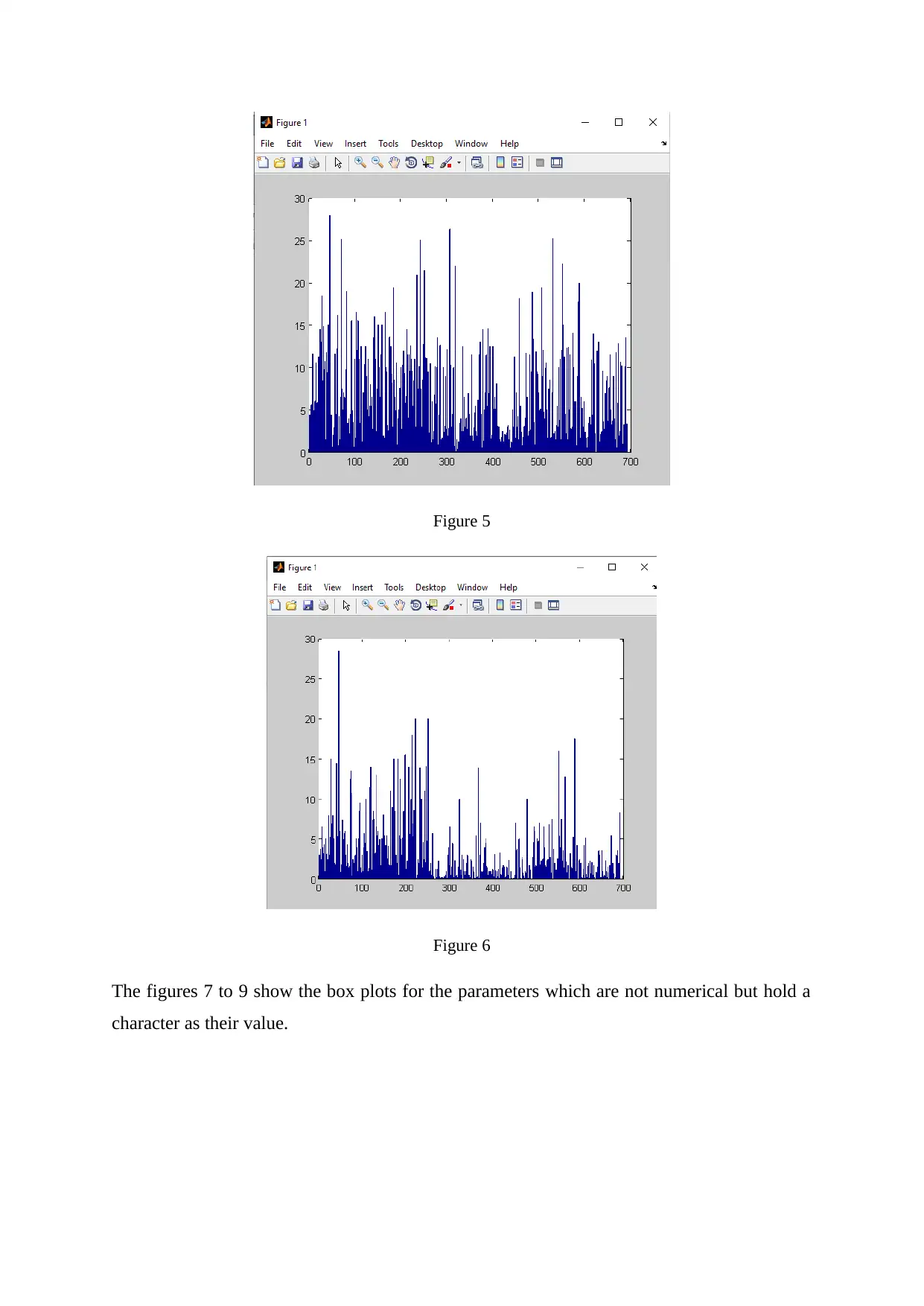
Figure 5
Figure 6
The figures 7 to 9 show the box plots for the parameters which are not numerical but hold a
character as their value.
Figure 6
The figures 7 to 9 show the box plots for the parameters which are not numerical but hold a
character as their value.
Paraphrase This Document
Need a fresh take? Get an instant paraphrase of this document with our AI Paraphraser
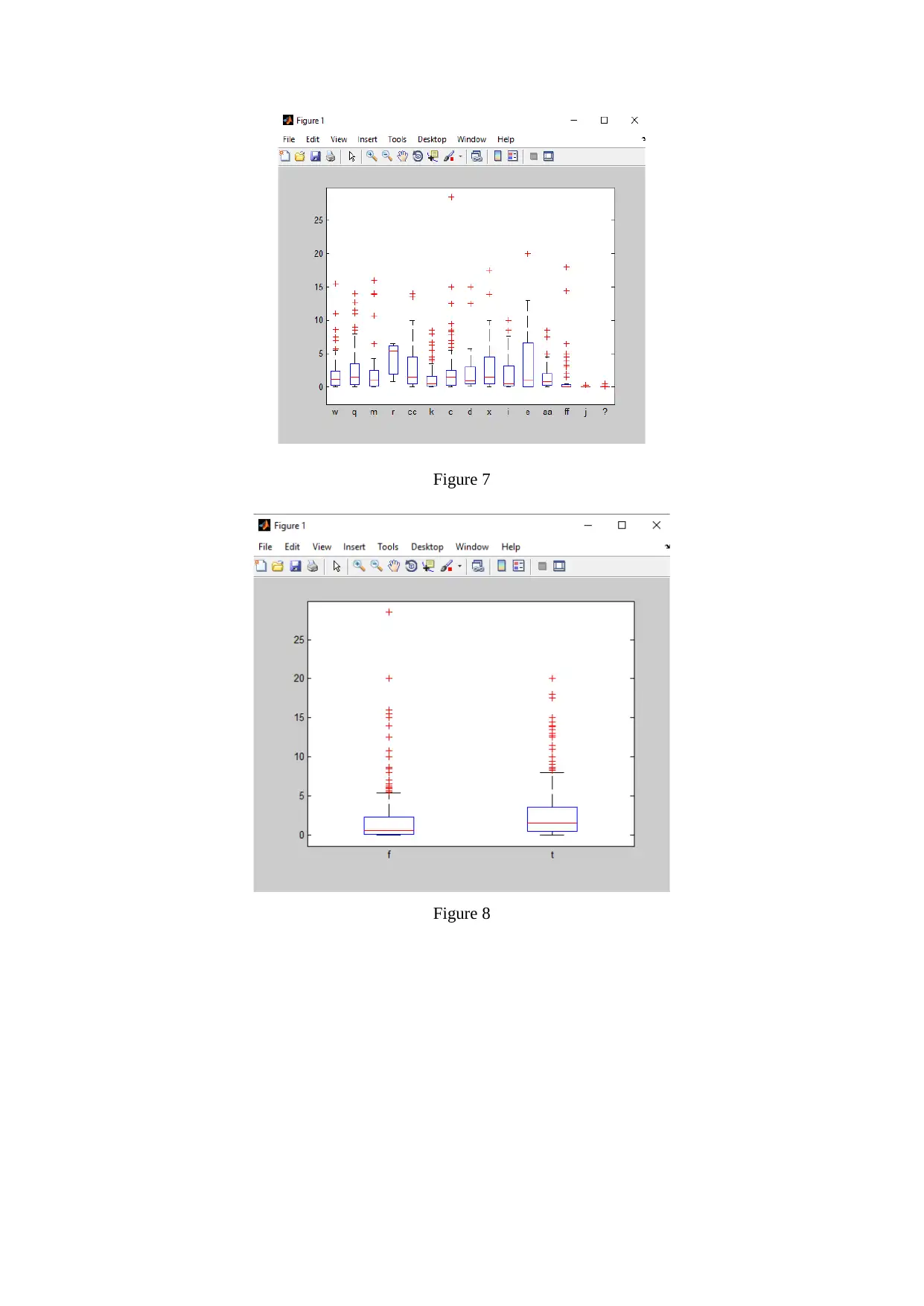
Figure 7
Figure 8
Figure 8
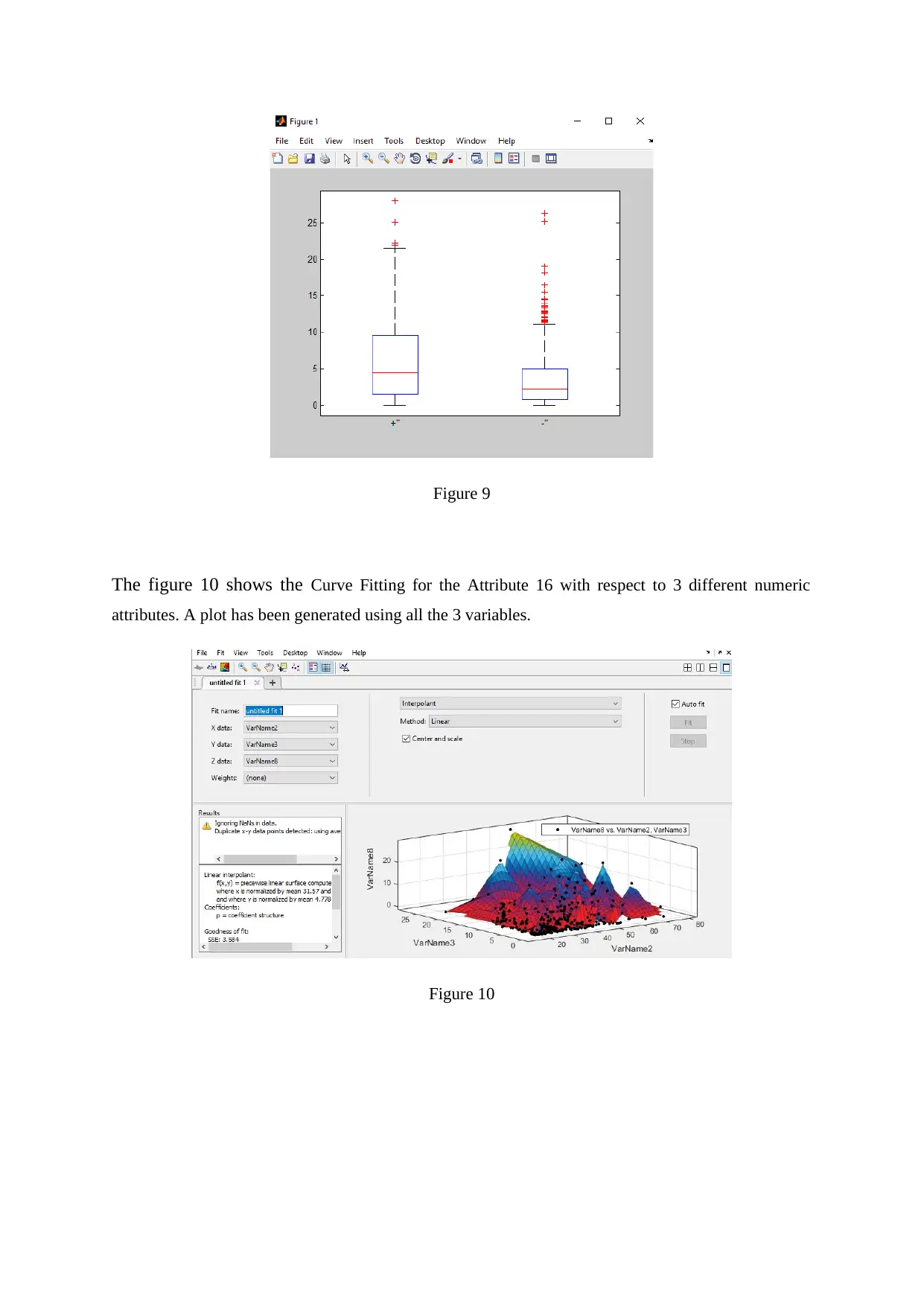
Figure 9
The figure 10 shows the Curve Fitting for the Attribute 16 with respect to 3 different numeric
attributes. A plot has been generated using all the 3 variables.
Figure 10
The figure 10 shows the Curve Fitting for the Attribute 16 with respect to 3 different numeric
attributes. A plot has been generated using all the 3 variables.
Figure 10
⊘ This is a preview!⊘
Do you want full access?
Subscribe today to unlock all pages.

Trusted by 1+ million students worldwide
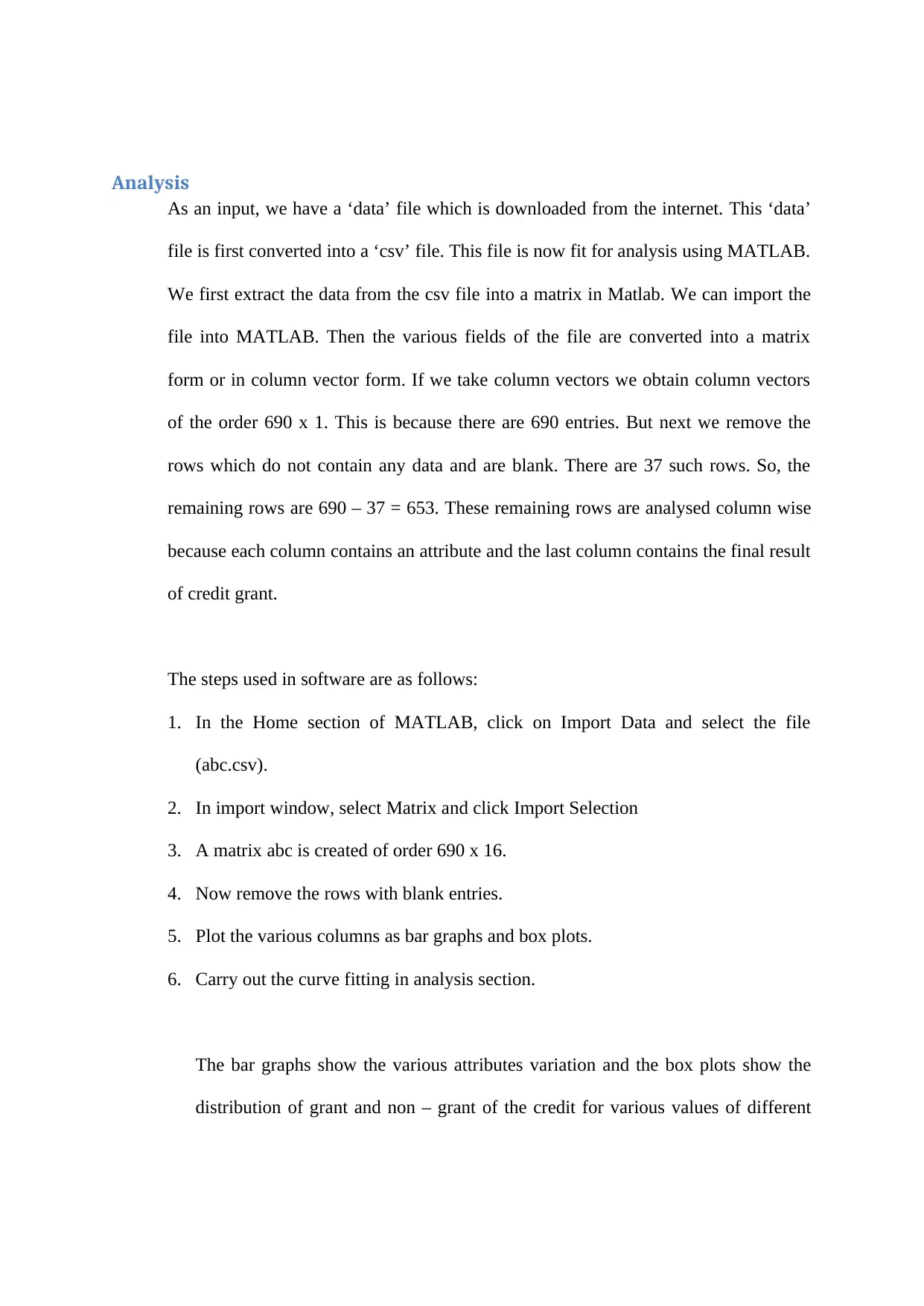
Analysis
As an input, we have a ‘data’ file which is downloaded from the internet. This ‘data’
file is first converted into a ‘csv’ file. This file is now fit for analysis using MATLAB.
We first extract the data from the csv file into a matrix in Matlab. We can import the
file into MATLAB. Then the various fields of the file are converted into a matrix
form or in column vector form. If we take column vectors we obtain column vectors
of the order 690 x 1. This is because there are 690 entries. But next we remove the
rows which do not contain any data and are blank. There are 37 such rows. So, the
remaining rows are 690 – 37 = 653. These remaining rows are analysed column wise
because each column contains an attribute and the last column contains the final result
of credit grant.
The steps used in software are as follows:
1. In the Home section of MATLAB, click on Import Data and select the file
(abc.csv).
2. In import window, select Matrix and click Import Selection
3. A matrix abc is created of order 690 x 16.
4. Now remove the rows with blank entries.
5. Plot the various columns as bar graphs and box plots.
6. Carry out the curve fitting in analysis section.
The bar graphs show the various attributes variation and the box plots show the
distribution of grant and non – grant of the credit for various values of different
As an input, we have a ‘data’ file which is downloaded from the internet. This ‘data’
file is first converted into a ‘csv’ file. This file is now fit for analysis using MATLAB.
We first extract the data from the csv file into a matrix in Matlab. We can import the
file into MATLAB. Then the various fields of the file are converted into a matrix
form or in column vector form. If we take column vectors we obtain column vectors
of the order 690 x 1. This is because there are 690 entries. But next we remove the
rows which do not contain any data and are blank. There are 37 such rows. So, the
remaining rows are 690 – 37 = 653. These remaining rows are analysed column wise
because each column contains an attribute and the last column contains the final result
of credit grant.
The steps used in software are as follows:
1. In the Home section of MATLAB, click on Import Data and select the file
(abc.csv).
2. In import window, select Matrix and click Import Selection
3. A matrix abc is created of order 690 x 16.
4. Now remove the rows with blank entries.
5. Plot the various columns as bar graphs and box plots.
6. Carry out the curve fitting in analysis section.
The bar graphs show the various attributes variation and the box plots show the
distribution of grant and non – grant of the credit for various values of different
Paraphrase This Document
Need a fresh take? Get an instant paraphrase of this document with our AI Paraphraser
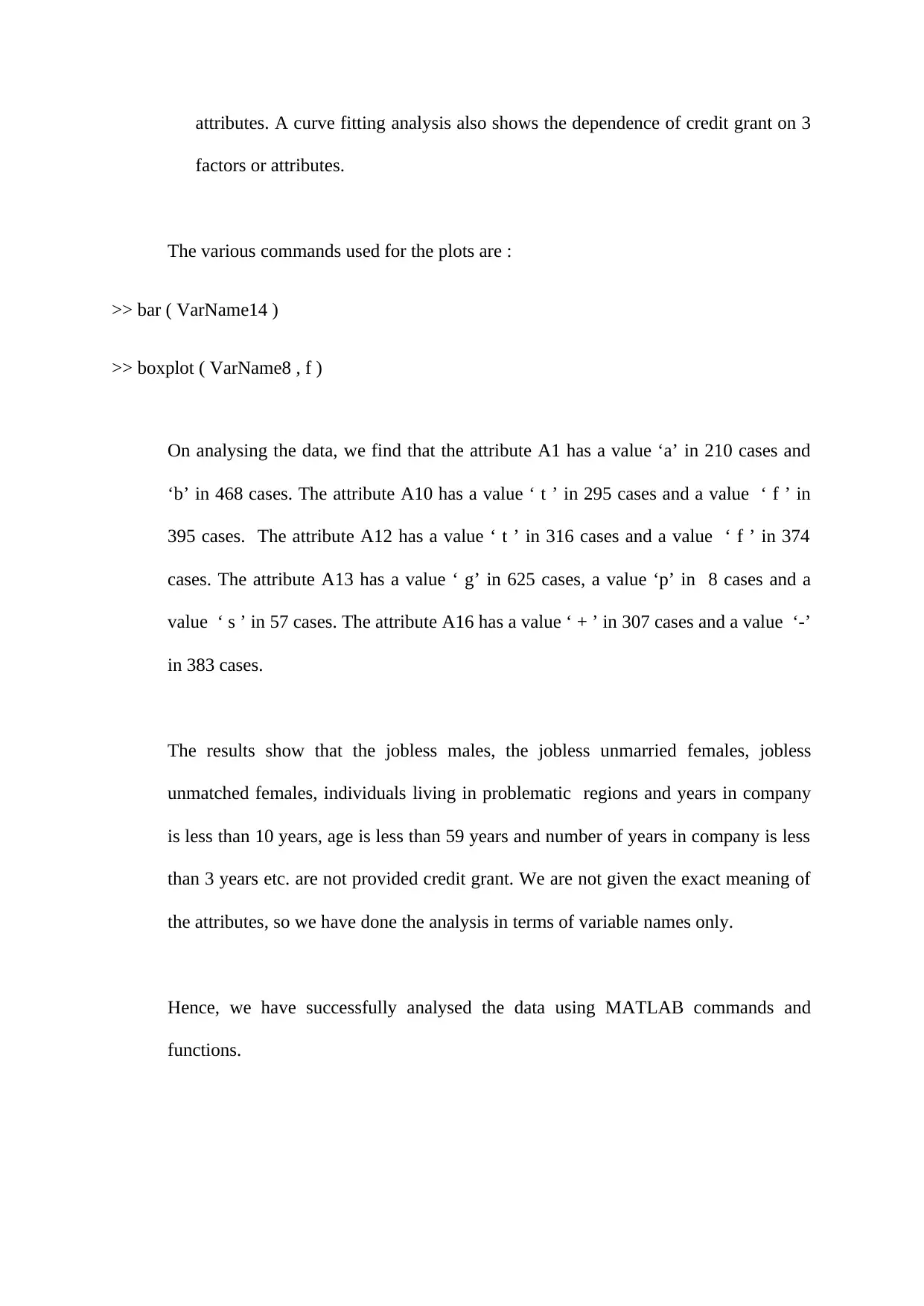
attributes. A curve fitting analysis also shows the dependence of credit grant on 3
factors or attributes.
The various commands used for the plots are :
>> bar ( VarName14 )
>> boxplot ( VarName8 , f )
On analysing the data, we find that the attribute A1 has a value ‘a’ in 210 cases and
‘b’ in 468 cases. The attribute A10 has a value ‘ t ’ in 295 cases and a value ‘ f ’ in
395 cases. The attribute A12 has a value ‘ t ’ in 316 cases and a value ‘ f ’ in 374
cases. The attribute A13 has a value ‘ g’ in 625 cases, a value ‘p’ in 8 cases and a
value ‘ s ’ in 57 cases. The attribute A16 has a value ‘ + ’ in 307 cases and a value ‘-’
in 383 cases.
The results show that the jobless males, the jobless unmarried females, jobless
unmatched females, individuals living in problematic regions and years in company
is less than 10 years, age is less than 59 years and number of years in company is less
than 3 years etc. are not provided credit grant. We are not given the exact meaning of
the attributes, so we have done the analysis in terms of variable names only.
Hence, we have successfully analysed the data using MATLAB commands and
functions.
factors or attributes.
The various commands used for the plots are :
>> bar ( VarName14 )
>> boxplot ( VarName8 , f )
On analysing the data, we find that the attribute A1 has a value ‘a’ in 210 cases and
‘b’ in 468 cases. The attribute A10 has a value ‘ t ’ in 295 cases and a value ‘ f ’ in
395 cases. The attribute A12 has a value ‘ t ’ in 316 cases and a value ‘ f ’ in 374
cases. The attribute A13 has a value ‘ g’ in 625 cases, a value ‘p’ in 8 cases and a
value ‘ s ’ in 57 cases. The attribute A16 has a value ‘ + ’ in 307 cases and a value ‘-’
in 383 cases.
The results show that the jobless males, the jobless unmarried females, jobless
unmatched females, individuals living in problematic regions and years in company
is less than 10 years, age is less than 59 years and number of years in company is less
than 3 years etc. are not provided credit grant. We are not given the exact meaning of
the attributes, so we have done the analysis in terms of variable names only.
Hence, we have successfully analysed the data using MATLAB commands and
functions.
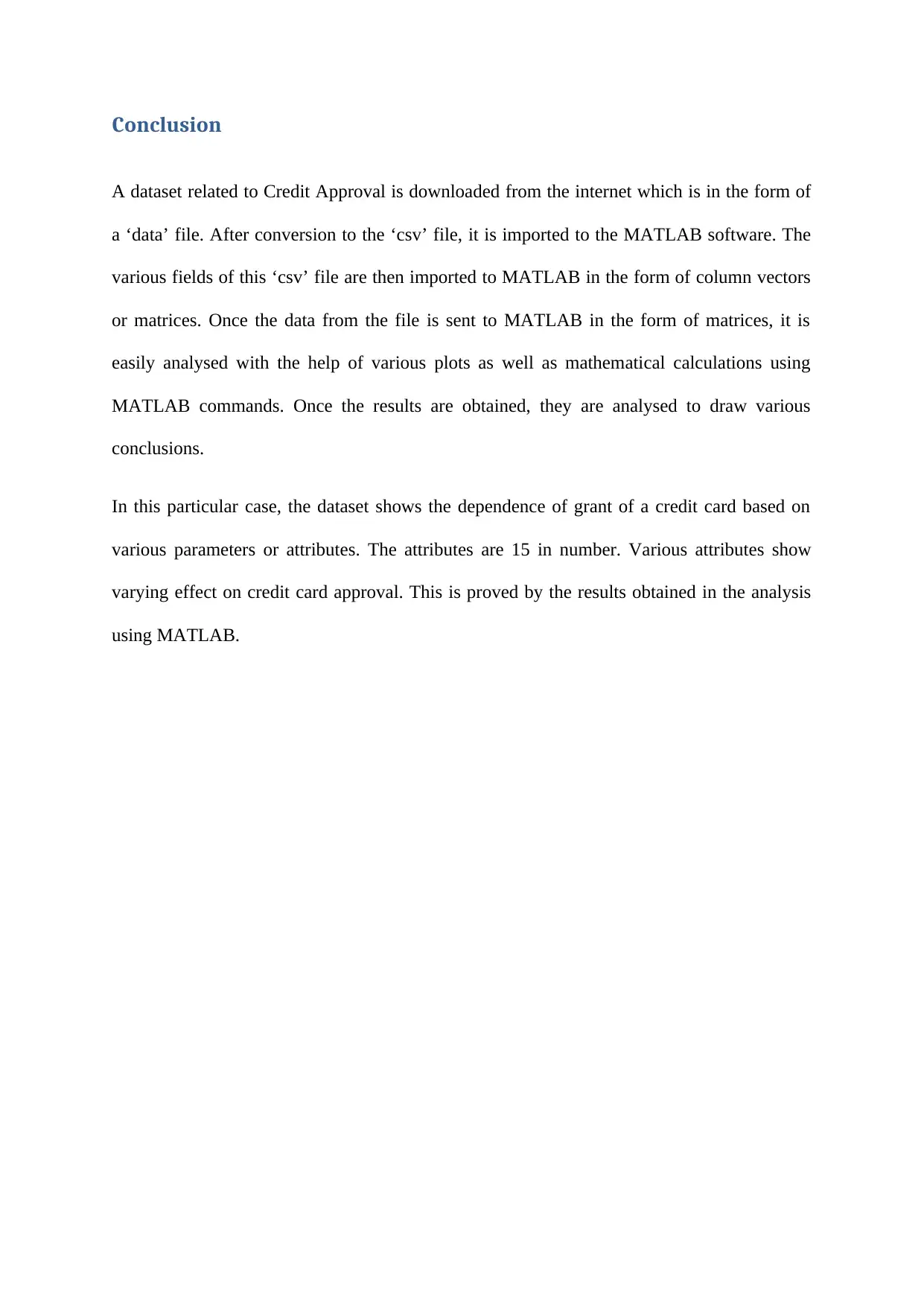
Conclusion
A dataset related to Credit Approval is downloaded from the internet which is in the form of
a ‘data’ file. After conversion to the ‘csv’ file, it is imported to the MATLAB software. The
various fields of this ‘csv’ file are then imported to MATLAB in the form of column vectors
or matrices. Once the data from the file is sent to MATLAB in the form of matrices, it is
easily analysed with the help of various plots as well as mathematical calculations using
MATLAB commands. Once the results are obtained, they are analysed to draw various
conclusions.
In this particular case, the dataset shows the dependence of grant of a credit card based on
various parameters or attributes. The attributes are 15 in number. Various attributes show
varying effect on credit card approval. This is proved by the results obtained in the analysis
using MATLAB.
A dataset related to Credit Approval is downloaded from the internet which is in the form of
a ‘data’ file. After conversion to the ‘csv’ file, it is imported to the MATLAB software. The
various fields of this ‘csv’ file are then imported to MATLAB in the form of column vectors
or matrices. Once the data from the file is sent to MATLAB in the form of matrices, it is
easily analysed with the help of various plots as well as mathematical calculations using
MATLAB commands. Once the results are obtained, they are analysed to draw various
conclusions.
In this particular case, the dataset shows the dependence of grant of a credit card based on
various parameters or attributes. The attributes are 15 in number. Various attributes show
varying effect on credit card approval. This is proved by the results obtained in the analysis
using MATLAB.
⊘ This is a preview!⊘
Do you want full access?
Subscribe today to unlock all pages.

Trusted by 1+ million students worldwide
1 out of 13
Your All-in-One AI-Powered Toolkit for Academic Success.
+13062052269
info@desklib.com
Available 24*7 on WhatsApp / Email
![[object Object]](/_next/static/media/star-bottom.7253800d.svg)
Unlock your academic potential
Copyright © 2020–2025 A2Z Services. All Rights Reserved. Developed and managed by ZUCOL.

